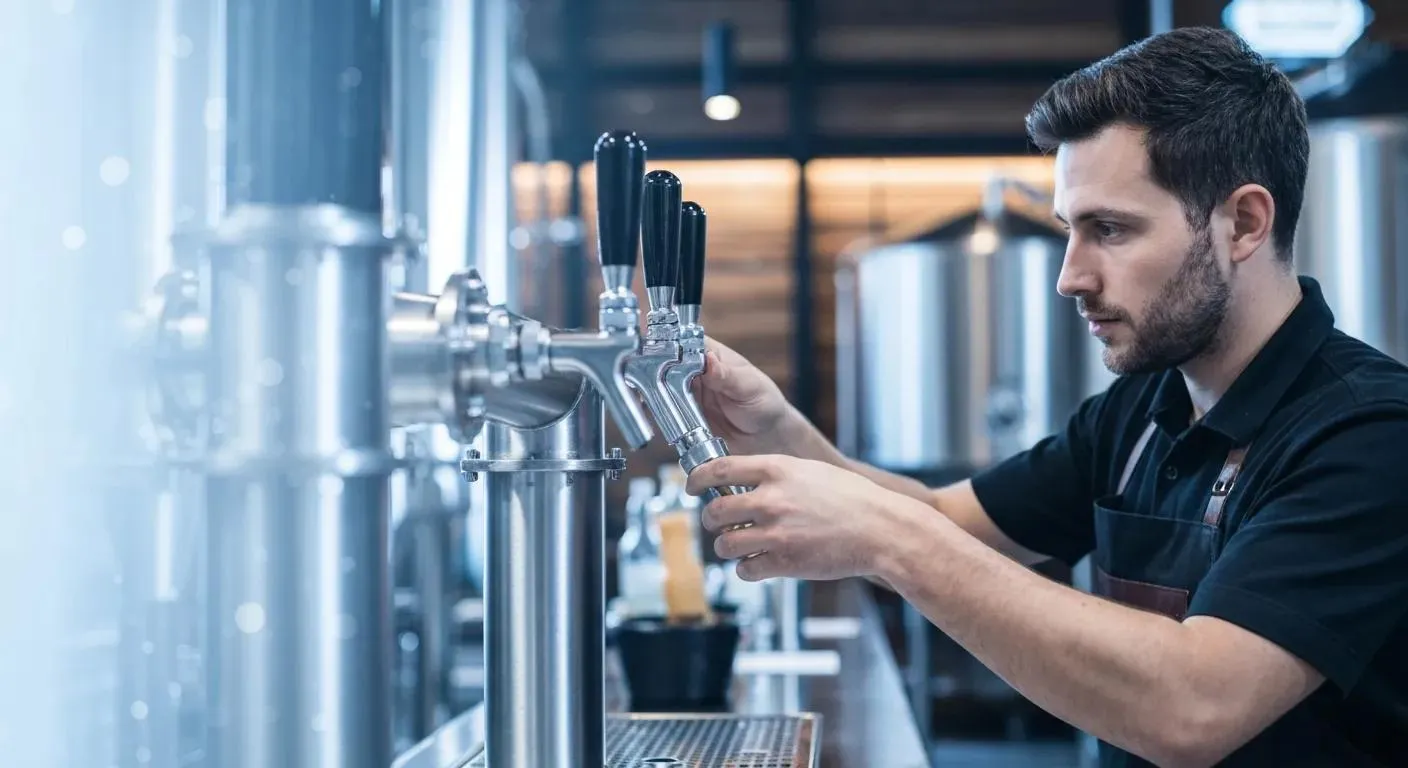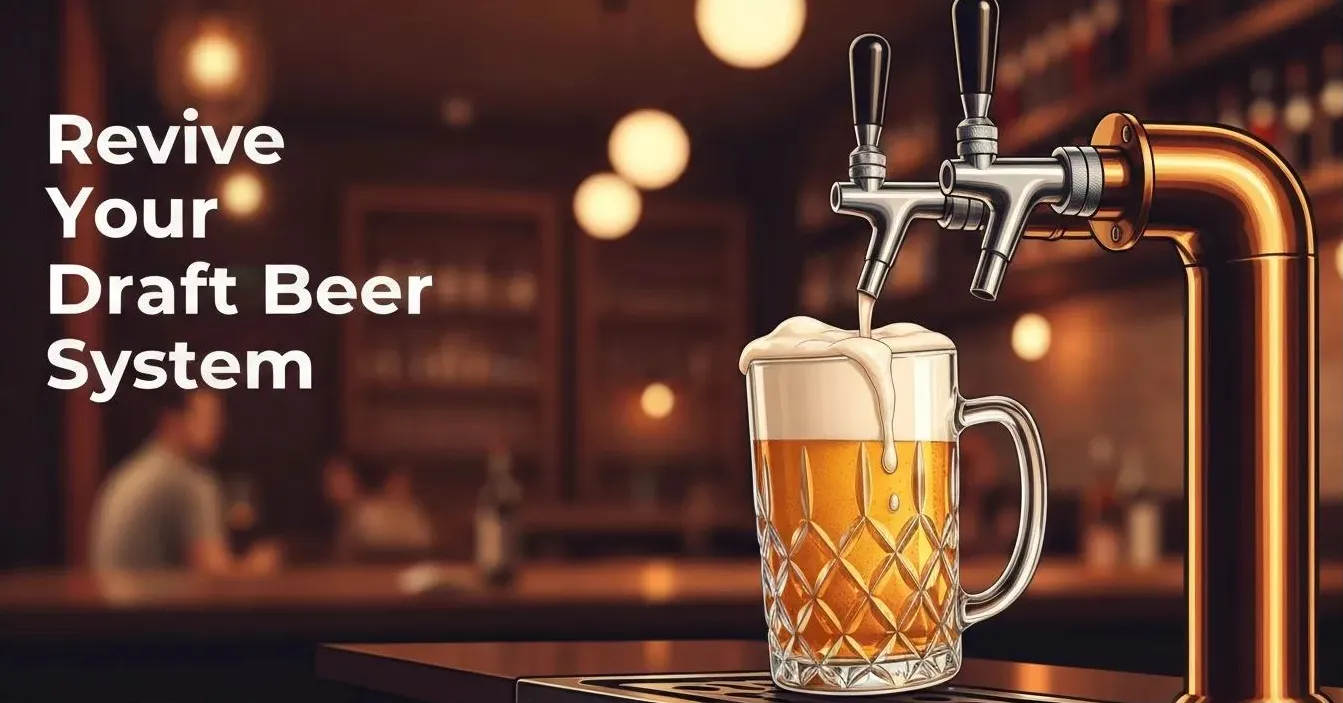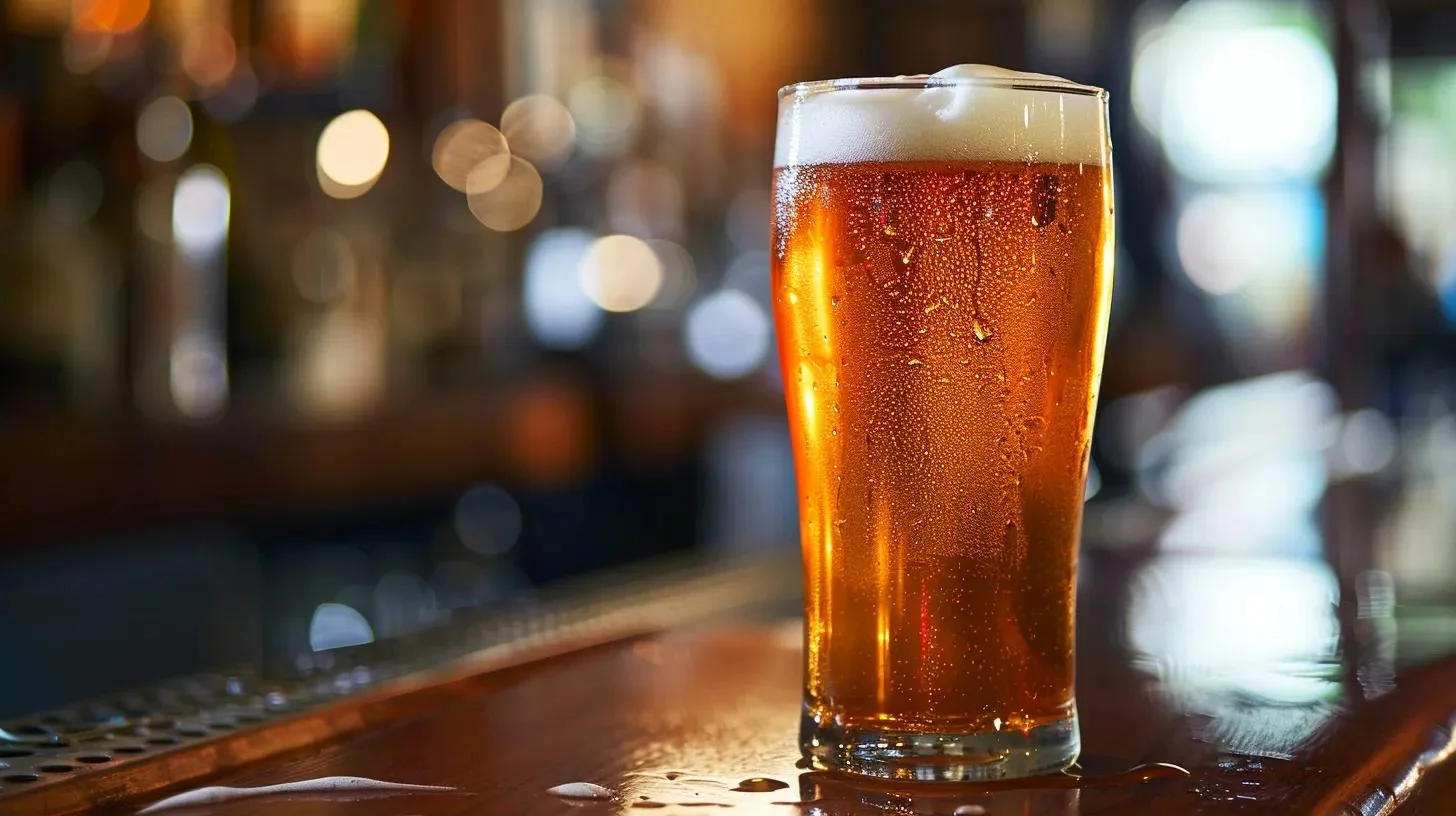Flat Beer Frustrations? Expert Tips to Fix Your Flat Beer Dilemma

Is your beer flat, lacking the bubbly sensation you were looking forward to? From improper storage temperatures to pressure issues, we pinpoint the prime causes for flat beer and offer expert guidance to help prevent or fix this flat fate, ensuring your next pour is as fizzy as intended.
Key Takeaways
- Flat beer happens when carbonation is lost, turning it tasteless or even into vinegar; temperature, pressure, and cleanliness can all cause your beer to lose its fizz.
- The correct temperature is essential for good beer - too warm and the beer goes flat, too cold and it dulls the flavor. Different beers need different temps, so check your labels!
- Consistent and proper pressure settings are crucial for optimal carbonation - not enough CO2 makes your beer flat, too much and you’ll be drowning in foam.
- Understanding beer's limited shelf life is important. Proper storage and timely consumption are necessary to avoid off-flavors or spoilage.
Understanding Flat Beer: The Basics

Flat beer is like a deflated balloon at a party - it just doesn’t add to the fun. Characterized by a lack of fizz or head, flat beer is a result of lost carbonation. You might be wondering, why does carbonation matter so much? Well, carbonation adds to the body and a slight sourness to the beer, enhancing the overall drinking experience. Without it, beer becomes flat and can ultimately turn stale or even metamorphose into vinegar if exposed to air. An off-tasting beer is the last thing you need when you’re trying to relax, isn’t it?
Carbonation is generated during the fermentation process, where yeast converts sugars into alcohol and carbon dioxide.
So, how does a perfectly brewed beer become unpalatable? The culprits are more common than you might think. Issues with temperature, pressure, and cleanliness can all rob your beer of its lively effervescence. We’ll further investigate these factors that can ruin your beer.
What is Flat Beer?
Flat beer is a type of beer that has lost its carbonation, resulting in a lack of fizz or bubbles. This can occur due to various reasons, such as improper storage, handling, or serving techniques. When beer loses its carbonation, it can become dull and lifeless, stripping away the refreshing experience that beer enthusiasts crave. Imagine expecting a crisp, bubbly sip only to be met with a flat, uninspiring taste—disappointing, right? Understanding what causes flat beer is the first step in preventing it and ensuring every pour is as enjoyable as the brewer intended.
Role of Carbonation
The effervescence and foam, known as the head of beer, transform each mouthful into a joyful experience while also playing a critical role in maintaining the beverage’s freshness.
Carbonation is generated through fermentation. During this natural phenomenon, yeast breaks down sugar to create alcohol and carbon dioxide (CO2). The alcohol content of beer is determined during fermentation and remains unchanged over time. A portion of this CO2 remains within the liquid giving it its bubbly characteristic. In contrast to this traditional method, there’s forced carbonation, which involves directly injecting CO2 into beer held in a sealed vessel—this technique is especially common when conditioning beer in kegs.
Causes of Flat Beer
Temperature, pressure, and cleanliness are significant factors that influence the carbonation levels in your beer. Beer retains more CO2 when kept at colder temperatures. Conversely, warm temperatures facilitate a faster release of CO2.
Using cold water for cleaning beer lines is crucial for ensuring that all chemicals are removed, thereby improving the beer's carbonation and overall quality.
It is essential for beer to carbonate over an adequate time frame. Insufficient carbonation time may lead to a lackluster taste due to flat beer. In contrast, too much carbonation might result in undesirable excessive foam formation. Maintaining an optimal equilibrium between temperature and pressure is crucial for preventing your beer from becoming flat.
Identifying the Problem
Identifying the problem of flat beer requires a closer look at the beer’s appearance, taste, and aroma. Here are some common signs and symptoms of flat beer:
- Lack of Carbonation or Fizz: One of the most obvious signs is the absence of bubbles rising to the surface.
- Flat or Stale Taste: The beer may taste dull or stale, lacking the crispness and bite that carbonation provides.
- Unpleasant Aroma or Odor: Flat beer can sometimes develop off-putting smells, indicating it has lost its freshness.
- Cloudy or Murky Appearance: While some beers are naturally cloudy, an unexpected murkiness can be a sign of flat beer.
- Sediment or Particles: Finding sediment or particles at the bottom of the bottle or glass can also indicate that the beer has gone flat.
By recognizing these signs, you can take steps to address the issue and restore your beer to its intended quality.
Signs and Symptoms of Flat Beer
Flat beer can exhibit a range of signs and symptoms, including:
- Lack of Head or Foam: A proper beer should have a nice head of foam when poured. If this is missing, it’s a clear sign of flat beer.
- Flat or Dull Sound When Opening: When you open a bottle or can, you should hear a satisfying hiss. A dull sound indicates a lack of carbonation.
- Unpleasant or Sour Taste: Flat beer often tastes off, with a sour or unpleasant flavor that detracts from the enjoyment.
- Unusual or Off-Putting Aroma: The aroma of flat beer can be musty or sour, a far cry from the fresh scent of a well-carbonated brew.
- Visible Sediment or Particles: Sediment or particles floating in the beer or settled at the bottom can be a sign that the beer has lost its carbonation.
Recognizing these symptoms can help you diagnose flat beer and take corrective measures.
Temperature Troubles: How Temperature Affects Your Beer

The relationship between beer and temperature is complex. A cold beer often epitomizes the essence of refreshment, but maintaining the ideal temperature is critical for preserving both its taste and carbonation. If a beer becomes too warm, its levels of carbonation can diminish, leading to an unwelcome flatness.
Maintaining proper temperature is crucial for preserving the intended taste of fresh beer and avoiding stale flavor profiles caused by oxidation.
Brewers suggest specific serving temperatures to maintain their beer’s intended flavor profile and adequate carbonation. This balance with temperature can be tricky. When served overly chilled, it can dampen the flavor complexities within the brew—while at elevated temperatures, there’s a risk that it will foam excessively or lose its crisp carbonation quickly. Now let us delve into finding that perfect middle ground where your beer keeps all of its characteristically desired attributes.
Ideal Serving Temperature
The ideal serving temperature for beer varies depending on its type. For instance, lagers are best served at cooler temperatures between 34°F to 36°F, while ales prefer a bit warmer temperatures between 36°F to 38°F.
Different beers react to temperature changes in various ways. While some beers are engineered for aging, other beer may lose flavor and develop off-putting profiles over time.
But what about those unique brews like nitrogenated beers and cask-conditioned ales? These special types should not be served too cold, as it might mask their unique textures and complex flavors.
So, the next time you pour yourself a beer, pay attention to the temperature. It can be the difference between a good beer and a great one!
Temperature Fluctuations
We've previously touched upon the optimal temperatures at which various beers should be served, yet it's just as critical to keep beer storage at a constant temperature. Beer can become flat if subjected to varying temperatures.
You may be curious about why beer that is warmer than its recommended serving temperature could lose its stability. Specifically, when the temperature rises above 38°F, this might result in too much foam and ultimately a lackluster taste sensation. Thus, ensuring your beer remains at an unwavering temperature is vital – after all, no one enjoys attending a celebration only to find tepid beverages!
Pressure Pointers: Balancing CO2 Levels
Pressure plays a pivotal role in determining the carbonation level of draft beer, much like how a conductor orchestrates rhythm and pace in a musical ensemble. It is essential for delivering the expected texture and excellence of the beverage.
Methods for reviving flat beers include adjusting pressure and temperature to re-carbonate the beer.
Should the CO2 pressure fall below optimum levels, this results in a flat beer lacking effervescence. Conversely, excessive pressure can lead to an abundance of foam. Hence, finding that perfect equilibrium of pressure is crucial for preserving the bubbly nature of draft beer that tantalizes your palate upon each tasting.
Proper CO2 Pressure
Much like fine-tuning a guitar for harmonious sound, setting the proper CO2 pressure in a draft beer system is critical to achieving an ideal pour while avoiding flat or overly carbonated brews. The optimal pressure varies with the variety of beer being served. Typically, ales such as pale ales, IPAs, and ambers thrive at CO2 pressures from 12 to 14 psi. Contrastingly, lagers often fare best when pressurized between 12 to 14 psi. It's not simply about increasing pressure indiscriminately—it requires adjusting it precisely according to the specific type of draft beer on tap.
Adjusting Pressure
So what do you do when you're faced with a flat beer in a kegerator? You adjust the regulator to increase the CO2 pressure, of course! This will help re-carbonate the beer.
Over-carbonation can also be a problem, but it can be mitigated by following these steps:
- Pull the pressure release valve on the keg.
- Shake the keg to release some CO2.
- Reattach the gas line with a set CO2 pressure of around 12PSI after letting the keg sit for a few hours.
So, with a few adjustments here and there, you can ensure your beer is at its carbonated best, avoiding the undesirable state of uncarbonated beer!
Glassware Guidance: Ensuring Beer-Friendly Glasses

The vessel containing your preferred beer, encompassing craft beers, plays a crucial role in shaping the enjoyment of your beer consumption. It is vital to serve draft beer in pristine glasses that are at room temperature. Conversely, bottled beer provides an alternate drinking experience. Proper bottling techniques in beer bottles are crucial for preventing flat beer and ensuring a good brewing experience.
Glasses that have not been adequately cleaned, contain soap residue or are overly cold can detrimentally impact the level of carbonation in your beer. Thus, it’s imperative not to overlook the importance of a spotless glass at room temperature for savoring a delightful pint with an ideal head!
Beer Clean Glasses
A clean beer glass is like a good friend to your beer. It forms a proper foam head, allows lacing during consumption, and has no bubbles stuck to the side, preserving the beer's carbonation and flavor.
Achieving clean beer glasses involves:
- Using appropriate cleaning agents
- Thoroughly scrubbing the glass
- Ensuring proper sanitation either manually in a three-tub sink or with an automatic glass washer
- Air-drying the glasses
- Storing the glasses in a way that promotes air circulation, in an environment free from odors.
So, give your beer the friend it deserves - a beer-clean glass!
Glass Temperature
The temperature of both the beer and its glass is pivotal. When a glass is too cold, almost frozen, it can impair our ability to fully appreciate the flavors due to a numbing effect on our taste buds similar to that caused by icy water.
Glasses chilled to such an extent may instigate undue frothiness in your beer when ice crystals prompt a swift liberation of CO2. This could prematurely flatten your beers, detracting from their quality and enjoyment.
Ideally keeping beer glasses within 36-40 degrees Fahrenheit strikes the perfect balance for enhancing refreshment without compromising flavor integrity. A suitably tempered glass ensures that you experience more than just good beer – it elevates it to greatness!
Cloudy and Foamy Beer Concerns

Most beer aficionados might be troubled by cloudy or foamy beer. A beer can become cloudy if there is wheat, proteins, or yeast content within it. Conversely, foamy beer usually arises from excessive carbonation or elevated serving temperatures.
The act of a can opening signifies the first introduction of air to the beer, marking an immediate sensory experience associated with fresh beer.
Fear not though! Beer is more resilient than you might think. Armed with proper understanding and some simple solutions, these concerns of a cloudy and overly foamy beer can easily be managed. Let’s dive into ways to rectify the problems associated with cloudiness and foam in your pint of beer.
Identifying Cloudy Beer Causes
The first step in solving a problem is identifying the cause, and cloudy beer is no different. Proteins and tannins binding together can result in hazes, giving the beer a cloudy appearance.
Cloudy beer can be caused by a few different factors, including:
- Yeast remaining in suspension
- Incomplete mash process leading to starch haze
- Beers containing wheat or rye, which are naturally cloudy due to their grain compositions
Once you've identified the cause, you can take the necessary steps to improve your beer's clarity.
Tackling Foamy Beer
Foam beer can be as disappointing as flat beer. But the good news is, it can be tackled with a few simple steps. The pouring foamy technique, for instance, has a significant impact on beer foam. The optimal way is to hold the glass at a 45-degree angle and moderate the faucet opening to reduce foam.
Incorrect tank pressure settings can also cause the beer to be too foamy. Proper adjustment of CO2 pressure is vital in this case.
Lastly, maintaining a consistent and appropriate temperature is crucial to avoid over-foaming. Extreme temperature fluctuations should be avoided. So, with the right technique and settings, you can ensure your beer has just the right amount of foam.
Solutions for Flat Beer
Fortunately, there are several solutions to revive flat beer or prevent it from happening in the first place. Here are some common solutions:
- Check the Storage and Serving Temperature: Ensure that the beer is stored and served at the ideal temperature, usually between 36°F and 38°F. This helps maintain the carbonation and flavor.
- Check the Pressure: For draft systems, ensure that the pressure in the keg or bottle is at the recommended level. Proper pressure is crucial for maintaining carbonation.
- Clean the Beer Lines and Taps: Regular cleaning of the beer lines and taps can help prevent flat beer by removing any buildup that might affect the beer’s quality.
- Use the Right Glassware: Using the right glassware can help preserve the carbonation and flavor of the beer. A beer-clean glass ensures that the beer’s head forms properly and retains its bubbles.
By following these solutions, you can enjoy a perfectly carbonated beer every time.
Reviving Flat Beer
If your beer has gone flat, there are a few things you can try to revive it:
- Increase the Pressure: If the beer is under-carbonated, increasing the pressure in the keg or bottle can help re-carbonate the beer. Adjust the CO2 levels to the recommended settings.
With these methods, you can bring your flat beer back to life and enjoy it as it was meant to be.
Draft Beer System Maintenance
A properly kept draft beer system operates smoothly, like a well-oiled machine. It helps preserve the quality and flavor of beer, avoiding ruined beer due to inadequately maintained draft beer systems or serving normal beers instead of draft beer.
Regular cleaning is necessary to prevent the build-up of bacteria, yeast, mold, and beer stone, and to maintain beer quality, which affects the beer served and can result in lost sales. The Brewers Association recommends cleaning a draft beer dispensing system at least once every two weeks to maintain system components and beer quality.
So, like any good piece of machinery, a draft beer system needs regular maintenance to perform at its best.
Regular Cleaning
Beer lines should be cleaned at least every 2 weeks or every time a new keg is tapped to prevent flat beer. To maintain a clean beer line, draught lines require cleaning with an alkaline detergent cleaner every two weeks to remove proteins and films, ensuring no dirty beer lines occur.
Quarterly acid cleanings are essential to remove inorganic compounds such as beer stone from the lines. For thorough cleaning, the chemical should be recirculated for at least 15 minutes or left in-line for 20 minutes when recirculation isn't possible. Faucets must be fully disassembled and cleaned every two weeks, replacing any damaged seals or gaskets.
Safety is paramount when handling line-cleaning chemicals, so always wear personal protective equipment. Regular cleaning not only improves the quality of your beer but also ensures a safe and efficient draft beer system.
Inspecting Components
Regular inspections of CO2 and nitrogen tanks, regulators, and couplers are essential to detect leaks or damage that can compromise beer system performance. Beer lines should be checked for kinks or obstructions that could affect beer flow, with immediate cleaning and replacement of any parts that cannot be adequately cleaned.
Utilizing components made of 100 percent stainless steel is recommended to preserve beer quality and enhance the reliability of the draft beer system. For glycol-cooled systems, biannual visual inspections of trunk lines are vital to spot signs of ice buildup, insulation damage, and possible leaks. So, regular inspection is like a health checkup for your draft beer system, ensuring it stays in top-notch condition.
In conclusion, a great beer experience is influenced by various factors - carbonation, temperature, pressure, glassware, and maintenance. Understanding and controlling these factors can help you avoid flat beer frustrations and enhance your overall beer experience. So, the next time you pop open a cold one, remember these expert tips, and you're sure to enjoy a perfect pint!




